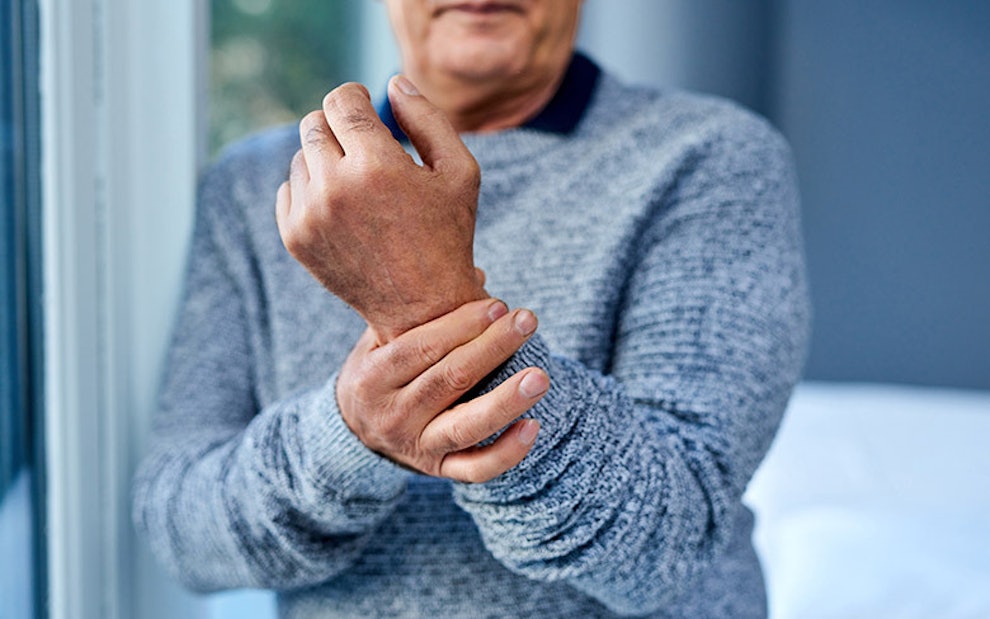Types of Arthritis: Symptoms and Risk Factors
Article at a glance
Arthritis is a term used to describe over 100 different types of diseases that cause swelling of the joints. To learn more about the most common types of arthritis, read this section.
Arthritis is a painful and long-term illness that may be debilitating in some cases. Being able to recognize the early signs of arthritis can facilitate early diagnosis and prompt treatment. To learn more about the signs and symptoms of arthritis, read this section.
There are certain behaviors and circumstances that can increase a person’s risk of developing arthritis. To learn more about the risk factors for arthritis, read this section.
- The ability to freely move our bodies is something we can take for granted at times. It’s not until we start to feel pain, or restriction, that we realize just how much this can impact our lives. It can start off with something as simple like stiffness in your hands, but can become severe enough to the point where it becomes impossible to do the things you did previously. Arthritis can lead to these profound changes. But knowing what the condition is, recognizing it early on, and knowing what increases your chances of developing it, can help prevent such complications from happening.

What is arthritis?
Arthritis is chronic inflammation (swelling) of one or more joints – the area where 2 or more bones meet (e.g., fingers, knees, hips, elbows). Arthritis itself is actually not a type of illness, but a term used to describe a group of medical conditions that cause joint pain or joint disease. Around 23% of American adults (more than 54 million) have arthritis, and it’s a leading cause of work disability in the country. Anyone can have arthritis regardless of age, gender, or race, but it’s more common in women and older people.
What are the most common types of arthritis?
Osteoarthritis
Osteoarthritis (OA) is the most common type of arthritis in the US, affecting over 30 million adults, especially in the older population. It’s also known as degenerative joint disease or “wear and tear” arthritis. As the name implies, it’s characterized by progressive inflammation and degeneration of the affected joints, ultimately resulting in pain, stiffness, and decreased flexibility. This is due to the breakdown of cartilage (tissue that helps with movement and acts as a cushion and shock absorber) within the joints, and changes in the underlying bone. It can lead to decreased function, and in severe cases can cause disability. Although it can be seen in any joint, OA primarily affects weight-bearing joints like the knees, hips, lower back, and the hands (specifically, the last joint at the end of the fingers, and base of the thumbs).
Gout
Gout affects approximately 8.3 million Americans. It’s a common type of arthritis that usually comes and goes (flares). It occurs when the body has excess amounts of uric acid (hyperuricemia), which can form into crystals and accumulate in the joint, usually on the big toe. Uric acid is produced when the body breaks down a chemical called purine, which can be found in many foods and beverages such as seafood, red meat, alcohol, and drinks with high-fructose corn syrup. Hyperuricemia can occur if there’s overproduction of uric acid — which can be seen with purine-rich diets, exercise, and certain diseases — or if there’s a decrease in uric acid excretion (e.g. due to kidney disease, drugs, thyroid disease). It’s more common in men, and in those who are overweight or obese.
Fibromyalgia
Approximately 2% (roughly around 4 million) of American adults have fibromyalgia. It’s a long-term illness most commonly first diagnosed in middle-aged women, and is characterized by widespread pain and stiffness felt all over the body. Although the cause is unknown, it’s thought that people with fibromyalgia have abnormal pain perception processing, which makes them more sensitive to pain compared to others. The pain may worsen with activity, in cold or damp weather, or during times of anxiety or stress.
Psoriatic arthritis
Psoriatic arthritis (PsA) affects approximately 2.25 million Americans. It’s a type of arthritis seen in people with psoriasis, an inflammatory condition that causes skin cells to grow at an accelerated rate. Both psoriasis and PsA are autoimmune diseases, which means that the body’s immune cells mistake certain cells in the body as foreign and attack them. Aside from pain and swelling in the affected joints, psoriasis can cause a distinct red rash with silvery scales on patches of the skin.
Rheumatoid arthritis
Rheumatoid arthritis (RA) affects as many as 1.5 million Americans. Similar to PsA, RA is a long-term autoimmune disease with symptoms that can come and go in flares. It primarily affects the joints of the wrist, hands, feet, spine, and knees. Aside from painful swelling, stiffness, loss of function, and deformity of the affected joints, RA inflammation can cause problems in other organs such as the lungs, heart, and eyes. Those with RA may also experience some weight loss, unusual tiredness, weakness, occasional fevers, and loss of appetite.
Lupus
Around 1.5 million Americans have lupus (also known as systemic lupus erythematosus, or SLE), and it’s believed that this number is underestimated. It’s a long-term, autoimmune condition that affects many areas of the body, including the joints, skin, heart, lungs, kidney, and brain. Similar to those who have gout, PsA, and RA, people with lupus may have periods of wellness (remission) and periods of illness (flares). There’s no specific pattern, and symptoms can range anywhere from mild to severe. These symptoms include extreme tiredness, a butterfly-shaped facial rash, fever, hair loss, and mouth sores.
Ankylosing spondylitis
Ankylosing spondylitis (AS) is an inflammatory disease that affects more than 1 million Americans. It’s more common in men, and often appears during early adulthood. Although AS mostly affects the spine, inflammation in other areas (e.g., hips, ribs, shoulders, knees) can occur as well. If not treated, the progressive inflammation in the spinal joints can cause stiffness or even fusion of the bones, which can lead to a rigid and immobile spine.
Reactive arthritis
Reactive arthritis (formerly known as Reiter’s syndrome) is a painful swelling of the joints due to an infection. It’s more commonly seen in men and those between 20–50 years of age. Even though it’s caused by an infection, the arthritis itself is not contagious. The infection can be acquired through sexual contact (e.g., chlamydia), or from food (e.g., salmonella, shigella). This form of arthritis occurs when the bacteria gains access to the blood stream, which makes the body react by causing inflammation in several different areas. This reaction usually happens within 2–4 weeks after the infection. Unlike other types of arthritis, such as OA, gout, and RA, most cases of reactive arthritis are not chronic and will resolve within a year.
What are the symptoms of arthritis?
Although the signs and symptoms of arthritis vary between the different types, they all share a common feature, which is the inflammation of a joint. There are several important early warning signs of arthritis, which include:
- Pain: may be constant or comes and goes, may happen at rest or during movement, may be isolated in one area or affect multiple parts of the body
- Swelling: the skin overlying the joint can sometimes get red, warm, and swollen
- Stiffness: may be felt early in the morning, after prolonged periods of not moving, or following exercise
- Difficulty moving a joint
What are the risk factors for arthritis?
The different types of arthritis each have their own risk factors. But in general, there are certain behaviors and characteristics that can increase a person’s chance of getting arthritis or making it worse. These include:
Being overweight or obese
Excess weight adds more stress on weight-bearing joints such as the knees and hips, putting those who are overweight or obese at an increased risk of getting knee osteoarthritis or worsening an already existing arthritis. Being obese (in addition to purine-rich diets, alcohol intake, and consuming food and drinks high in fructose) also makes it more likely for a person to develop hyperuricemia, which can cause gout.
Getting an infection
Germs like bacteria, viruses, and fungi can infect the joints and cause specific types of arthritis, such as reactive arthritis.
Sustaining injuries to the joints
Injuries to or overuse of joints (e.g., repeated stress, bending the knees) can cause damage and lead to the development of osteoarthritis.
Occupation
Similarly, jobs that require repetitive squatting or bending the knees can lead to osteoarthritis.
Smoking
Cigarette smoking is a risk factor for rheumatoid arthritis. Studies have also shown that smoking can worsen OA and RA, and make PsA treatment less effective.
Having other medical conditions
The existence of other medical conditions can increase a person’s chance of developing certain types of arthritis. For example, the risk of gout is increased if a person has congestive heart failure, high blood pressure, diabetes, or poor kidney function; psoriatic arthritis is seen in about 30% of patients with psoriasis; and those who have inflammatory bowel disease (i.e., Crohn’s disease, ulcerative colitis), or psoriasis are more likely to develop ankylosing spondylitis.
Age
The risk of developing most forms of arthritis increases as a person grows older.
Gender
Osteoarthritis, rheumatoid arthritis, lupus, and fibromyalgia are more commonly seen in women, while gout and ankylosing spondylitis are more commonly seen in men.
Genetics
Inheriting specific genes can increase a person’s risk of having arthritis, especially the autoimmune types (e.g., rheumatoid arthritis, lupus, ankylosing spondylitis).
Arthritis is a chronic, painful, and sometimes disabling disease. It can take on many different forms, but with early recognition and timely care, it can be appropriately managed, and your quality of life can be preserved.
Sources
- https://medlineplus.gov/jointd…
- https://www.arthritis.org/heal…
- https://www.cdc.gov/chronicdis…
- https://curearthritis.org/oste…
- https://www.niams.nih.gov/heal…
- https://www.cdc.gov/arthritis/…
- https://cartilage.org/patient/…
- https://curearthritis.org/gout…
- https://my.clevelandclinic.org…
- https://www.ncbi.nlm.nih.gov/b…
- https://www.cdc.gov/arthritis/…
- https://www.hopkinsmedicine.or…
- https://curearthritis.org/psor…
- https://www.psoriasis.org/abou…
- https://my.clevelandclinic.org…
- https://www.cdc.gov/arthritis/…
- https://www.niams.nih.gov/heal…
- https://curearthritis.org/lupu…
- https://www.niams.nih.gov/heal…
- https://www.cdc.gov/lupus/feat…
- https://curearthritis.org/anky…
- https://www.niams.nih.gov/heal…
- https://www.hopkinsmedicine.or…
- https://www.arthritis.org/dise…
- https://www.arthritis.org/heal…
- https://www.cdc.gov/arthritis/…
- https://www.cdc.gov/arthritis/…
- http://blog.arthritis.org/living-with-arthritis/smoking-risks-ra-oa/
- https://www.ncbi.nlm.nih.gov/pmc/articles/PMC9044547/
Become a patient
Experience the Oak Street Health difference, and see what it’s like to be treated by a care team who are experts at caring for older adults.




